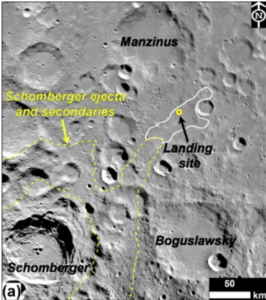IASbaba's Daily Current Affairs Analysis
Archives
(PRELIMS & MAINS Focus)
Syllabus:
- Prelims & Mains – CURRENT EVENT
Context: A study by scientists from the Indian Space Research Organisation (ISRO) has estimated that the region where Chandrayaan-3 landed on the Moon is approximately 3.7 billion years old—coinciding with the period when primitive microbial life first emerged on Earth.
Background: –
- India’s Chandrayaan-3 mission achieved a historic milestone on August 23, 2023, as it landed on the Moon’s south polar region, making India the fourth country to achieve a soft landing on the lunar surface and the first to reach the Moon’s South Pole.
Key takeaways
- A team of scientists from Isro’s Physical Research Laboratory (PRL), Ahmedabad, has performed morphological and topographic analysis within the Chandrayaan-3 landing site, now known as the Shiv Shakti point.
- With the help of data generated by the Pragyan rover housed inside the Vikram lander onboard Chandrayaan-3, Indian scientists have been uncovering new interpretations and insights into the moon’s evolution.
- The latest study described the regional geography around the Shiv Shakti point.
- The Chandrayaan-3 landing site is enclosed between multiple large-impact craters: Manzinus (diameter about 96 km, age about 3.9 billion years) to the north, Boguslawsky (diameter about 95 km, age about 4 billion years) to the southeast, and Schomberger (diameter about 86 km, age about 3.7 billion years) to the south.
- Over the years, images have helped lunar scientists globally to rebuild the history of Manzinus and Boguslawsky, with both craters appearing to have flat crater floors and subdued crater wall structures.
- Each of these craters is categorised as shallow, with Boguslawsky being hollower than Manzinus and Schomberger. What distinguishes the Schomberger crater is its depth and well-preserved structures — including the central peak, wall terrains, raised crater rim, and steep crater walls — along with an ejecta blanket.

Source: Indian Express
Syllabus:
- Prelims & Mains – CURRENT EVENT
Context: Union government’s announcement that it would amend the Civil Liability for Nuclear Damages Act (CLNDA), 2010, and the Atomic Energy Act, 1962, is likely to enthuse American and French nuclear power companies, whose projects have been deadlocked due to legal concerns for more than 15 years.
Background: –
- The announcement, which marked a sharp U-turn from the government’s position in 2015, was made in the Budget speech on February 1.
- In particular, it is meant to help progress the Electricite de France (EDF) MoU to build six EPR1650 reactors at Jaitapur in Maharashtra that was signed in 2009 (with Areva), and American Westinghouse Electric Company’s (WEC) MoU, signed in 2012, to build six AP1000 reactors at Kovvada in Andhra Pradesh.
Key takeaways
- Currently, India has a nuclear power capacity of 6,780 MW from 22 reactors, and the only foreign operator in India is Russia’s Rosatom.
- The CLNDA has been the biggest impediment to private sector participation due to a provision that pins liabilities on nuclear suppliers in addition to the operator in case of nuclear damage.
- Western nuclear power companies says that clauses in the CLNDA are unacceptable as they mandate a high degree of liability for suppliers and contradict the international Convention for Supplementary Compensation for Nuclear Damage (CSC) which focuses only on the liability of operators of the plant.
- The clauses were inserted in 2012, where the then-in-Opposition NDA members had accused the government of letting Western companies off from liability, citing the Union Carbide-Bhopal gas leak case that killed thousands in 1984 and the Fukushima nuclear leak in Japan in 2011.
- Officials aware of discussions on the issue said that while the CLNDA would be amended to separate operator’s liability from supplier’s liability to bring it in line with the CSC, the Atomic Energy Act would liberalise investment in power projects in India.
Source: The Hindu
Syllabus:
- Prelims & Mains – POLITY
Context: A regional party in poll-bound Meghalaya has indicated that bringing the State under the purview of Article 371 could help resume rat-hole coal mining, which has been banned since April 2014.
Background:
- Voice of the People Party (VPP) cited the example of Nagaland to seek Article 371 for Meghalaya.
Key takeaways
- Special provisions provided to some States are listed in Articles 371 (A-J) in Part XXI of the Constitution, which deals with “temporary, transitional and special powers for certain States.” While Articles 370 (now abrogated) and 371 have been a part of the Constitution since 1950, Articles 371 (A-J) were incorporated in subsequent years through amendments.
- Article 371 of the Indian Constitution grants special provisions to Maharashtra and Gujarat.
- Article 371A was made in 1962 after a deal was struck between the Centre and the Naga People’s Convention creating the State of Nagaland. Under the provision, no Act of Parliament about the religious or social practices of the Nagas, their customary law and procedure, including civil and criminal justice matters, and ownership or transfer of land and resources will apply to Nagaland, unless the State’s Legislative Assembly passes a resolution to do so. Further, non-residents can’t buy land in Nagaland.
- Article 371B deals with Assam.
- Article 371C applies to Manipur and was inserted into the Constitution in 1972.
- Articles 371D and E include special provisions for Andhra Pradesh.
- Article 371F takes into account the unique status of Sikkim after its merger with India in 1975 and grants protection to existing laws. Only descendants of Sikkim subjects (those who lived in the State before its merger with India) whose names were mentioned in the 1961 register have the right to own land and get State government jobs in Sikkim.
- Article 371G applies to Mizoram. It includes special provisions to preserve the religious and social practices, customary law, and procedure of Mizos in Mizoram, as well as for the administration of criminal and civil justice, besides ownership and transfer of land.
- Article 371H confers a special responsibility on the Governor of Arunachal Pradesh concerning law and order.
- Article 371I relates to Goa. It requires the Legislative Assembly of Goa to consist of not less than 30 members.
- Article 371J accords special status to the Hyderabad-Karnataka Region (Kalyana Karnataka).
Source: The Hindu
Syllabus:
- Prelims & Mains – GEOGRAPHY
Context: Astronomers are sounding alarm bells as a precious sky-observing location faces risk of being blinded by light pollution due to a planned renewable energy project. U.S. company AES Energy wants to build a large renewable hydrogen manufacturing complex in Chile, only a few kilometers from the summit of Mount Paranal, the site of the European Southern Observatory’s (ESO) Very Large Telescope (VLT).
Background: –
- Mount Paranal, an 8,740-foot-high (2,664 m) peak in the Atacama Desert of Northern Chile, is one of the last spots on Earth free from urban and industrial light pollution.
Key takeaways
- The Atacama Desert, located in northern Chile, is one of the driest places on Earth and holds significant geographical, climatic, and scientific importance.
- Location: Western South America, along the Pacific coast, between the Andes Mountains and the Chilean Coastal Range.
- Climate: Hyper-arid with minimal rainfall due to the rain shadow effect of the Andes and the influence of the Humboldt Current and Subtropical High-Pressure Belt.
- Temperature: High diurnal temperature variation with hot days and cold nights.

Importance
- The desert contains several salt flats (salares) and high-altitude lagoons, such as the Salar de Atacama, which is rich in lithium deposits.
- The Salar de Atacama holds one of the largest lithium reserves globally, which is crucial for battery production in electric vehicles and renewable energy storage.
- The Atacama Desert is rich in mineral resources, particularly copper and lithium. Chile is one of the world’s largest producers of both.
- Home to unique microbial life, studied for its resemblance to Martian conditions.
- Ideal for astronomical observations due to its clear skies, low humidity, and high altitude.
- Hosts world-class observatories like the European Southern Observatory (ESO) and ALMA (Atacama Large Millimeter Array).
Source: space.com
Syllabus:
- Prelims – SCIENCE & TECHNOLOGY
Context: In a bid to raise awareness about the health benefits of medicinal plants, a species-specific campaign titled “Shatavari –For Better Health” was launched today by Shri Prataprao Jadhav, Minister of State (Independent Charge), Ministry of Ayush.
Background: –
- The campaign marks another significant step in the Ministry of Ayush’s continued efforts to promote traditional medicine and medicinal plants for better health and well-being in India.
Key takeaways
- Shatavari is a medicinal herb widely used in Ayurveda for its adaptogenic and rejuvenating properties.
- Native to India, Sri Lanka, and the Himalayas, it thrives in tropical and subtropical climates.
Medicinal & Health Benefits
- Known as the “Queen of Herbs” in Ayurveda for its role in women’s reproductive health.
- Used as a galactagogue (enhances breast milk production) and supports hormonal balance.
- Contains saponins, flavonoids, and alkaloids, which provide anti-inflammatory, antioxidant, and immune-boosting properties.
Economic & Agricultural Importance
- Cultivated in India’s tropical and subtropical regions, particularly in Madhya Pradesh, Chhattisgarh, Kerala, and Tamil Nadu.
- Recognized under the National Medicinal Plants Board (NMPB) for commercial cultivation and promotion of medicinal plants.
Government Initiatives & Conservation
- Promoted under AYUSH for herbal medicine development.
- Encouraged through National Agroforestry Policy and Medicinal Plants Mission for sustainable farming.
Source: PIB
Practice MCQs
Q1.) Consider the following statements regarding Article 371 of the Indian Constitution:
- Article 371 provides special provisions exclusively for the states of Nagaland and Mizoram.
- Article 371J accords special status to the Hyderabad-Karnataka region (Kalyana Karnataka).
- Article 371F deals with the special provisions for Arunachal Pradesh.
Which of the above statements is/are correct?
(a) 1 only
(b) 2 only
(c) 1 and 3 only
(d) 2 and 3 only
Q2.) Which of the following factors contribute to the extreme aridity of the Atacama Desert?
- The rain shadow effect of the Andes Mountains
- The influence of the Humboldt Current
- The presence of large freshwater lakes
- The Subtropical High-Pressure Belt
Select the correct answer using the codes given below:
(a) 1 and 2 only
(b) 1, 2, and 4 only
(c) 1, 3, and 4 only
(d) 2, 3, and 4 only
Q3.) Consider the following statements regarding Shatavari (Asparagus racemosus):
- It is primarily cultivated in temperate regions of India.
- It is widely used in Ayurveda for its role in women’s reproductive health.
- It is promoted under the National Medicinal Plants Board (NMPB) for commercial cultivation.
Which of the statements given above is/are correct?
(a) 1 and 2 only
(b) 2 and 3 only
(c) 1 and 3 only
(d) 1, 2, and 3
Comment the answers to the above questions in the comment section below!!
ANSWERS FOR ’ Today’s – Daily Practice MCQs’ will be updated along with tomorrow’s Daily Current Affairs
ANSWERS FOR 8th February – Daily Practice MCQs
Q.1) – d
Q.2) – b
Q.3) – c













